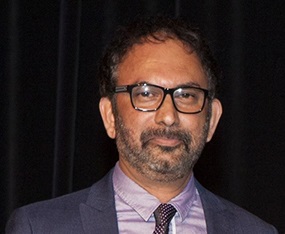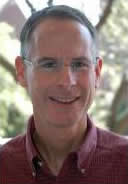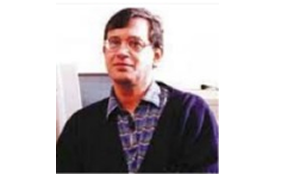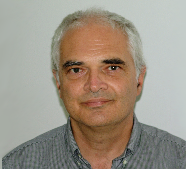|
||||||||||||||||||||||||||
|
||||||||||||||||||||||||||
|
|
||||||||||||||||||||||||||
|
||||||||||||||||||||||||||
|

Despite all the knowledge on nanotechnology generated over the last few decades, applying nanomaterials to commercial products can still be a difficult task. At the XVI B-MRS Meeting, Professor Pulickel Ajayan, one of the world’s references in nanomaterials and nanostructures, will shed light on this problem. In the plenary lecture he will address in Gramado on the morning of September 14, Ajayan will discuss some challenges of the application of nanomaterials (particularly those of two dimensions) in systems and devices. He will address issues related to the synthesis, characterization and modification of these materials.
Ajayan and his collaborators have developed nanomaterials with diverse functionalities, applicable to fileds such as energy storage and conversion, catalysis, low consumption electronics, nanomedicine or environment care. Among his most famous contributions, are carbon nanotubes filled with molten material acting as nanowire moulds (1993); nanobrushes made of carbon nanotubes, highlighted by Guinness World Records as the smallest ones (2005); the paper battery, made of cellulose and nanotubes (2007); the ultra-dark nanotube carpet, which reflects only 0.045% of light (2008), and a reusable sponge of nanotubes capable of absorbing oil dispersed in water (2012).
Professor and director of the Department of Materials Science and Nanoengineering at Rice University (USA), Ajayan has exceptional publication metrics: a h index of 144 and more than 95,000 citations according to Google Scholar.
Pulickel Madhavapanicker Ajayan was born in 1962 in India, in a small town in the southern state of Kerala. He attended primary school there and then went to the state capital, to a high school that aroused his enthusiasm for learning, his curiosity, and his interest in science.
In 1985, Ajayan graduated in Metallurgical Engineering at Banaras Hindu University (BHU), located in northeastern India and then went on to do a PhD in Materials Science and Engineering at Northwestern University (USA). At that moment, he began to penetrate nanotechnology. In 1989, he defended his PhD thesis about very small gold particles that, some years later, would begin to be called “nanoparticles”.
In 1990, he moved to Japan to pursue a postdoctoral stage at the Fundamental Research Laboratory of the NEC Corporation, where he remained until 1993 in the group that was responsible for a series of seminal studies on carbon nanotubes – including the “discovery” of these nanomaterials, attributed to Sumio Iijima in 1991. During his postdoc, Ajayan obtained important results on the synthesis of nanotubes in large scale and on the filling of nanotubes with other materials.
From Japan, he went to France where he worked as a researcher at the Solid Physics Laboratory of the Université Paris-Sud for two years. Then he went to Germany, where he worked for a year and a half at the Max-Planck-Institut für Metallforschung. In 1997, he moved to the United States to become an assistant professor at the Rensselaer Polytechnic Institute (RPI), the nation’s oldest university of technological research, located in the state of New York. At RPI, he was the Henri Burlage chair Professor in Engineering and worked in the nanotechnology research group.
In 2007, he left RPI and joined the faculty of the Department of Mechanical Engineering and Materials Science at Rice University to be the Benjamin M. and Mary Greenwood Anderson professor of Engineering. In 2014, he also held the founding chair of the Department of Materials Science and NanoEngineering.
Currently, in addition to teaching and leading a research group of about 40 members at Rice University, Ajayan travels a lot, whether to share his knowledge on nanotechnology (he has delivered more than 350 invited lectures and has held visiting professor positions at universities around the world), or to take care of his scientific collaborations. In addition, Ajayan has acted on the boards of several journals, startups and international conferences of the materials and nanotechnology field.
The scientist has received important awards from a number of institutions including the Royal Society of Chemistry (UK), Alexander von Humboldt Foundation (Germany), Materials Research Society (USA), Microscopic Society of America (USA). He also received distinctions of numerous universities around the world, including the doctorate honoris causa by the Université Catholique de Louvain (Belgium). He is an elected member of the Royal Society of Chemistry (UK), American Association for the Advancement of Science (AAAS), and the National Academies of Sciences of India and Mexico, among other scientific societies.
Here follows an interview with the scientist.
B-MRS newsletter: – We would like you to choose some of your contributions to nanotechnology, describe them briefly, and share the paper reference, if possible. Please choose:
– The one(s) you consider to have caused or will cause more social impact.
Pulickel Ajayan: – Several of our discoveries have commercial and social impact. In the past two decades some of the research highlights from our lab have been carbon nanotube arrays as extreme light absorbers (for thermo-photovoltaics), nanotube arrays as gecko-tapes, high conductivity carbon nanotube fibers, graphene oxide membranes for water filtration, carbon nanomaterials for energy storage, light weight polymer nanocomposites, development of two-dimensional materials for electronics and sensors, carbon based quantum dots as catalysis for example CO2 reduction etc.
– The one(s) that gave you more personal satisfaction.
Pulickel Ajayan: – One of the most exciting work was related to the conversion of carbon onions into diamond nanoparticles using electron irradiation. This work was done in collaboration with Prof. Florian Banhart when I was visiting as a post-doc at the Max Planck Institute for Metallforschung in Stuttgart in the mid-90’s. This work published in Nature magazine showed direct observation of graphite to diamond phase transition without application of any external pressure.
B-MRS newsletter: – Have any of your scientific/ technological contributions been transferred to a commercial product? If so, has this transfer occurred through patent licensing, start-up …?
Pulickel Ajayan: – Two start-up companies (Paper Battery Co. and Big Delta Systems) have come out of our work; both engage in unconventional energy storage technologies.
B-MRS newsletter – Leave an invitation to your plenary talk for our readers.
Pulickel Ajayan: – Nanotechnology is a paradigm changing approach on how we will be building materials of the future. It is at the core of bottom-up manufacturing and will impact several areas of future technologies. Our work in the past two decades have focused on creating nano-engineered materials with various types of nanoscale building blocks.
More information
On XVI B-MRS Meeting website, click on the photo of Pulickel Ajayan and see his mini CV and the abstract of his plenary lecture: http://sbpmat.org.br/16controter/home/

In the research group of Professor Kirk Schanze, conjugated polyelectrolytes (CPEs) have been the subject of both fundamental studies and applications. The group has already explore CPEs as fluorescent sensors, in solar cells and as biocidal materials.
On September 13, in Gramado, Kirk Schanze, who is a Professor at the University of Texas at San Antonio (UTSA) and editor-in-chief of ACS Applied Materials & Interfaces, will take some time out of his busy schedule to deliver a plenary lecture on CPEs in the XVI B-MRS Meeting.
Schanze graduated in Chemistry from Florida State University in 1979. Four years later, he earned his Ph.D., also in Chemistry, from the University of North Carolina at Chapel Hill. Soon after, he was appointed a Miller Postdoctoral Fellow at the University of California, Berkeley. In 1986, he joined the University of Florida (UF) as a professor of the Department of Chemistry. There, he chaired the Division of Organic Chemistry, held the Prominski Chair of Chemistry, and founded the Schanze Group, which today continues its research activities at UTSA. In 2016, Schanze left UF to hold the Robert A. Welch Distinguished University Chair in Chemistry at UTSA.
Between 2000 and 2008, Schanze served as senior editor of the prestigious journal Langmuir. Shortly thereafter, he became the first editor-in-chief of ACS Applied Materials & Interfaces, which had just been released.
Prof. Schanze has authored about 300 papers and 20 patents. According to Google Scholar, his scientific production has more than 16,000 citations and his h index is 71. He is fellow of the American Chemical Society (ACS). He was a visiting professor at the Harbin Institute of Technology (China) and the Tokyo Metropolitan University (Japan) in 2011, at the Ecole Normale Supérieure Cachan (France) in 2008 and at the Chemical Research Promotion Center (Taiwan) in 2007. He has received distinctions from the American Chemical Society, National Science Foundation, University of Florida, Japan Society for Promotion of Science, and Japanese Photochemical Association, among other entities.
Here follows an interview with the scientist.
B-MRS newsletter: – In your opinion, what are your main scientific and/ or technological contributions to the field of conjugated polyelectrolytes? Describe them briefly and feel free to share a few references of your papers, patents or books.
Kirk Schanze: – We were among the first groups to study conjugated polyelectrolytes, which are water soluble conjugated polymers. Following are some of the key contributions from our group to this field:
a) Our lab was the first to report the synthesis of a water soluble, fluorescent poly(phenylene ethynylene) sulfonate (PPE-SO3) and describe the application to fluorescence sensing of ions in water at ultralow concentration.[1]
b) We were the first to report the use of a fluorescent conjugated polyelectrolyte as a sensor for enzyme activity, which is an important biosensing application.[2]
c) Our lab has developed the applications of cationic conjugated polyelectrolytes to sensing phosphatase enzyme activity. These enzymes are important in a number of biologically significant processes. [3,4]
d) Working in collaboration with Prof. David Whitten of the University of New Mexico, we have developed cationic conjugated polyelectrolytes as a novel class of antibacterial agents.[5,6]
References:
[1] C. Tan, M. R. Pinto and K. S. Schanze, “Photophysics, Aggregation and Amplified Quenching of a Water-Soluble poly(Phenylene ethynylene)”, Chem. Commun. 2002, 446-447, 10.1039/B109630C.
[2] M. R. Pinto and K. S. Schanze, “Amplified Fluorescence Sensing of Protease Activity with Conjugated Polyelectrolytes”, Proc. Nat. Acad. Sci. USA, 2004, 101, 7505, 10.1073/pnas.0402280101.
[3] Zhao, X.; Liu, Y.; Schanze, K. S., “A Conjugated Polyelectrolyte Based Fluorescence Sensor for Pyrophosphate”, Chem. Commun. 2007, 2914-2916, 10.1039/b706629e.
[4] Zhao, X. Y.; Schanze, K. S., “Fluorescent Ratiometric Sensing of Pyrophosphate via Induced Aggregation of a Conjugated Polyelectrolyte”, Chem. Commun. 2010, 46, 6075-6077, 10.1039/c0cc01332c.
[5] Ji, E.; Corbitt, T. S.; Parthasarathy, A.; Schanze, K. S.; Whitten, D. G., “Light and Dark-Activated Biocidal Activity of Conjugated Polyelectrolytes”, ACS Appl. Mater. Interfaces 2011, 3, 2820-2829, 10.1021/am200644g.
[6] 299. Huang, Y.; Pappas, H. C.; Zhang, L.; Wang, S.; Cai, R.; Tan, W.; Wang, S.; Whitten, D. G.; Schanze, K. S., “Selective Imaging and Inactivation of Bacteria over Mammalian Cells by Imidazolium Substituted Polythiophene”, Chem. Mater. 2017, 2017, 29, 6389–6395, 10.1021/acs.chemmater.7b01796.
B-MRS Newsletter: – You have been the Editor-in-Chief of ACS Applied Materials & Interfaces since its release, haven´t you? In less than 10 years, the journal hit an impact factor of 7,504. To what factors do you attribute this good result?
Kirk Schanze: – ACS Applied Materials & Interfaces (AMI) publishes papers that come from a currently very active area of materials research, specifically applied materials/interfaces. There is a large community of scientists and engineers around the globe who are working in this field. AMI has a global community of editors and editorial board members who represent their regions. Indeed, the newest editor who has joined our editorial board is Prof. Osvaldo Oliveira Jr. of the University of Sao Paulo!
B-MRS Newsletter: – We often see papers from the Brazilian Materials Community at ACS Applied Materials & Interfaces. Could you share with our readers some numbers about the participation of Brazilian authors in the journal?
Kirk Schanze: – ACS Applied Materials & Interfaces has published more than 100 papers with authors or co-authors from Brazil. Many of these papers have been highly cited in the field of materials science. Examples of highly cited papers are:
B-MRS Newsletter: – Please, leave an invitation to your plenary talk.
Kirk Schanze: – Everyone is invited to attend my talk which will highlight our work of conjugated polyelectrolyte as applied in the field of energy- and bio- materials chemistry.
More information
On XVI B-MRS Meeting website, click on the photo of Kirk Schanze and see his mini CV and the abstract of his plenary lecture: http://sbpmat.org.br/16controter/home/

In the race to develop ever smaller and better performing chips, several technological limitations need to be overcome. Today, the bottlenecks to continue this trend lie mainly in techniques for manufacturing electronic circuits of less than 10 nanometers (nm). Among the techniques being improved to manufacture the next generation of chips, one of the most promising is extreme ultraviolet lithography (EUVL). This technology takes advantage of the very short wavelength of extreme ultraviolet radiation to pattern nanoscale circuits on the chip with the intermediation of the so-called “resists” – thin layers of radiation sensitive material that cover the chip substrate during nanofabrication.
At the XVI B-MRS Meeting, a plenary lecture will discuss an important contribution that the materials field can make to the next generation of chips: the development of suitable resists for the fabrication of electronic circuits of less than 10 nm through EUVL.
The subject will be presented by Kenneth E. Gonsalves, Distinguished Professor of the Indian Institute of Technology Mandi (IIT Mandi), a teaching and research institution created in 2009, where Gonsalves arrived in 2012 as a visiting professor.
Gonsalves obtained his BS in Chemistry from the University of Delhi (India) followed by an MS also in Chemistry from Boston College (USA) and a PhD from the University of Massachusetts at Amherst (USA) with a doctoral thesis on polymer synthesis. Then he performed a postdoctoral specialization on polymer ceramics at MIT (USA). From 2001 to 2014, Gonsalves was the Celanese Acetate Distinguished Professor of Polymer Materials at the University of North Carolina at Charlotte (USA).
Together with his research group at IIT and his collaborators from the United States, India, Brazil, Taiwan and Europe, Gonsalves carries out research and development on resists for advanced nanofabrication techniques, with support of major companies in the electronics segment, and on polymer scaffolds for tissue engineering.
Here follows a brief interview with the researcher.
B-MRS newsletter: – Tell us a little bit about your main scientific/ technological contributions up to the moment.
Kenneth Gonsalves: – My research has centered on polymers with an emphasis on synthesis of novel materials. For the last 20 years I have focused on resist technology for IC (integrated circuit) fab. This is a fascinating area as it has significant technological applications in the development of integrated circuits, solid state devices. In addition it can also be used successfully for cell and tissue engineering of scaffolds for biotechnologies.
B-MRS newsletter: – About the resists you are working on, what skills and expertise are needed to develop them, in your opinion? When this next generation of chips is expected to be available?
Kenneth Gonsalves: – Resist R&D is multifaceted and extremely complex. It requires extensive collaborations between chemists with organic, inorganic and polymer backgrounds. In addition, interaction with physicists and electrical/electronic engineers is essential. The next generation of chips at the 14 nm node are currently available. Sub 7 nm node technology is expected by 2018 onwards.
B-MRS newsletter: – Describe in the simplest and briefest possible way the process of EUVL, without forgetting to mention the role of resists.
Kenneth Gonsalves: – The EUV photons are generated by a plasma or synchrotron source operating at a wavelength of 13.5 nm. Through a series of special mirrors and a mask, the predesigned template for the IC fab is projected onto photosensitive materials such as polymers as well as inorganics. This is all conducted in vacuum, a challenge for the IC fab industry as it is a drastic change from current photolithography fab, which functions under ambient conditions. The extremely short EUV wavelength is a prerequisite for patterning features at the sub 20 nm scale. The challenges for resists that can meet the sub 7 nm node requirements are enormous. A new paradigm is paramount – hybrid resists, that are partially inorganic may provide solutions to patterning at these scales. Inorganic hardmasks are another alternative. The sensitivity of these photoresists has to be enhanced drastically in order to meet the mass volume production of chips. There are several other critical parameters that have to be met for a successful resist system. Again, this requires multidisciplinary, multi institutional, industry collaboration on a global scale.
——————
More information
On XVI B-MRS Meeting website, click on the photo of Kenneth Gonsalves and see his mini CV and the abstract of his plenary lecture: http://sbpmat.org.br/16encontro/home/
|
|||||||||||||||||||||||||||||||||||||||

At the University of Illinois at Chicago, Professor Alexander Yarin and his team use agro-waste materials derived from various plants and animals to form nanofibers. Such nanofibers possess important properties, which are of interest for various applications. The group demonstrated that the method they employ (solution blowing) can be implemented on the industrial scale using commercially available equipment.
At the XVI B-MRS Meeting (September 10-14, Gramado, Brazil), Yarin will deliver a plenary lecture on the fabrication and properties of these nanofibers formed from different agro-waste materials, and will show the results of their application as biomedical materials and adsorbents useful for heavy metal ion removal from polluted water. He will also discuss potential applications of such biodegradabe and biocompatible nano-textured membranes for protection of pruned plants from esca fungi and against mold invasion in wood.
Alexander L. Yarin graduated in Applied Physics from the Polytechnical Institute of St. Petersburg (Russia) in 1977. Then he moved to Moscow to the Institute for Problems in Mechanics of the USSR Academy of Sciences, where he remained until 1990 working as a researcher. In 1980, he received PhD in Physics and Mathematics and, in 1989, habilitation (DSc), both from the Institute for Problems in Mechanics. In parallel, Yarin was an adjunct Professor at the Physico-Technical Institute and at the Aviation Technology Institute in Moscow.
From 1990 to 2006, he was a Professor at the renowned Israeli university Technion (Israel Institute of Technology), where he held, from 1999, the Eduard Pestel Chair of Mechanical Engineering. During his sabbaticals, he was a visiting Professor at two American institutions, the University of Wisconsin-Madison (1996-1997) and the University of Illinois at Chicago (2003-2004).
Since 2006, Alexander Yarin is a Distinguished Professor of the Department of Mechanical and Industrial Engineering at the University of Illinois at Chicago. At this University, Yarin heads the Multiscale Mechanics and Nanotechnology Laboratory, a space of more than 2,200 square feet dedicated to the experimental and theoretical investigation of the mechanics of fluids and solids, mainly in the scale that ranges from a few millimeters to the nanometers.
Yarin is a Fellow of the American Physical Society (APS). He is an Associate Editor of the journal “Experiments in Fluids” and a member of the editorial boards of “Archives of Mechanics” and “Electrospinning”. He is a member of the International Editorial Advisory Board of the Bulletin of the Polish Academy of Sciences and a co-Editor of Springer Handbook of Experimental Fluid Mechanics published in 2008. He has received distinctions from the Israel Academy of Sciences and Humanities and from Technion (Israel), from the American Technion Society and the American Physical Society (United States), from the Technical University Darmstadt (Germany), from the Society of Mechanics of Taiwan, and from Elsevier, among others.
Owner of an h index of 54, Professor Yarin is the author of 4 books, 12 book chapters, 6 patents and about 300 scientific articles. His academic production has more than 21,500 citations, according to Google Scholar.
B-MRS newsletter: – In your plenary talk, you will talk about materials obtained by the process of solution blowing. Describe in few words what this process consists of and whether it is already used on an industrial scale.
Alexander Yarin: – Solution blowing is a relatively novel process designed to form monolithic and core-shell nanofibers from petroleum-derived and biopolymers derived from agro-waste (the latter are discussed in detail in the present talk). In this process, a slowly moving polymer solution jet is issued into a high-speed subsonic coaxial air jet. As a result, the polymer solution jet is stretched, then bends due to the aerodynamically-driven bending instability which causes dramatic stretching and thinning. In parallel, solvent evaporates, and precipitated dry nanofibers are deposited on a target surface in the form of a nonwoven mat. Recently, the solution blowing process was demonstrated using an industrially-available equipment and nanofiber mats containing soy protein were formed.
B-MRS newsletter: – What, in your opinion, are your main scientific or technological contributions to the field of nanofibers and related topics? Feel free to share some (few) references if you wish.
Alexander Yarin: – The explanation and theoretical description of the physical mechanisms involved in solution blowing and electrospinning, novel experimental methods and approaches, a wide usage of biopolymers, in particular, those derived as by-products of biofuel production, development of novel applications. Two recent comprehensive monographs outline many of the above-mentioned results:
B-MRS newsletter: – If you desire, leave an invitation to your plenary talk.
Alexander Yarin: – Green nano-textured materials can become such great scorers as Pele! Come and see how.
More information
On XVI B-MRS Meeting website, click on the photo of Alexander Yarin and see his mini CV and the abstract of his plenary lecture: http://sbpmat.org.br/16encontro/home/
Until August 14, undergratudate and graduate students who are authors of accepted abstracts can apply for the student awards of the XVI B-MRS Meeting. In addition to the traditional “Bernhard Gross Award” from the Brazilian Materials Research Society, this edition of the event will feature awards from the publisher of the American Chemical Society (ACS Publications), responsible for a number of very prestigious peer-reviewed scientific journals in the materials field.
The Bernhard Gross Award was established by SBPMat in honor of the pioneer of Brazilian materials research Bernhard Gross, and it distinguish the best works (up to 1 oral and 1 poster) from each symposium.
Among the winners of the Bernhard Gross Award, the three best posters and the three best oral presentations will receive the “ACS Publications Best Poster Prize” and the “ACS Publications Best Oral Presentation Prize” respectively. The prizes will consist of US $ 500 for each winning work, in addition to the certificate. The ACS awards will be sponsored by the following ACS’s journals: ACS Applied Materials & Interfaces, ACS Nano, Nano Letters, Chemistry of Materials, JACS and ACS Omega.
In order to compete for the prizes, students have to submit through the website of the event, an extended abstract, elaborated according to the template that is available in the instructions for authors.
The papers will be evaluated considering the quality of the extended abstracts and presentations, as well as the scientific contribution of the research work.
The Student Awards Ceremony will take place at the closing of the XVI B-MRS Meeting, on September 14. Prizes will only be given if the winner students are present at the ceremony.
